Guiyang Hou
Embodied-Reasoner: Synergizing Visual Search, Reasoning, and Action for Embodied Interactive Tasks
Mar 27, 2025Abstract:Recent advances in deep thinking models have demonstrated remarkable reasoning capabilities on mathematical and coding tasks. However, their effectiveness in embodied domains which require continuous interaction with environments through image action interleaved trajectories remains largely -unexplored. We present Embodied Reasoner, a model that extends o1 style reasoning to interactive embodied search tasks. Unlike mathematical reasoning that relies primarily on logical deduction, embodied scenarios demand spatial understanding, temporal reasoning, and ongoing self-reflection based on interaction history. To address these challenges, we synthesize 9.3k coherent Observation-Thought-Action trajectories containing 64k interactive images and 90k diverse thinking processes (analysis, spatial reasoning, reflection, planning, and verification). We develop a three-stage training pipeline that progressively enhances the model's capabilities through imitation learning, self-exploration via rejection sampling, and self-correction through reflection tuning. The evaluation shows that our model significantly outperforms those advanced visual reasoning models, e.g., it exceeds OpenAI o1, o3-mini, and Claude-3.7 by +9\%, 24\%, and +13\%. Analysis reveals our model exhibits fewer repeated searches and logical inconsistencies, with particular advantages in complex long-horizon tasks. Real-world environments also show our superiority while exhibiting fewer repeated searches and logical inconsistency cases.
Think Twice, Click Once: Enhancing GUI Grounding via Fast and Slow Systems
Mar 09, 2025Abstract:Humans can flexibly switch between different modes of thinking based on task complexity: from rapid intuitive judgments to in-depth analytical understanding. However, current Graphical User Interface (GUI) grounding systems which locate interface elements based on natural language instructions rely solely on immediate prediction without reasoning, struggling to understand complex interface layouts with nested structures and hierarchical relationships, limiting their effectiveness on complex interfaces. Inspired by human dual-system cognition, we present Focus, a novel GUI grounding framework that combines fast prediction with systematic analysis. The framework dynamically switches between rapid and deliberate processing through an adaptive system switching based on task complexity, optimizing both efficiency and accuracy. Focus decomposes grounding into progressive stages: interface summarization, visual focused analysis, and precise coordinate prediction. This structured decomposition enables systematic understanding of both interface layouts and visual relationships. Extensive experiments show that Focus achieves state-of-the-art performance using only 300K of the training data with a 2B parameter model compared to existing approaches. Focus demonstrates superior performance particularly in complex GUI scenarios, achieving 77.4% average accuracy on ScreenSpot and 13.3% on the more challenging ScreenSpot-Pro. Our analysis reveals the effectiveness of this dual-system approach while demonstrating its potential for improving complex GUI interaction scenarios.
GaVaMoE: Gaussian-Variational Gated Mixture of Experts for Explainable Recommendation
Oct 15, 2024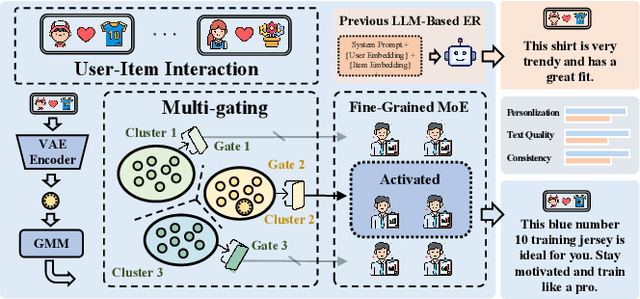
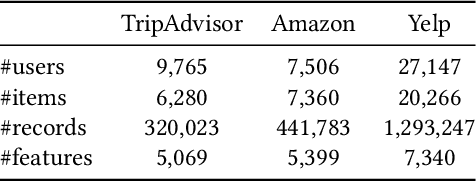
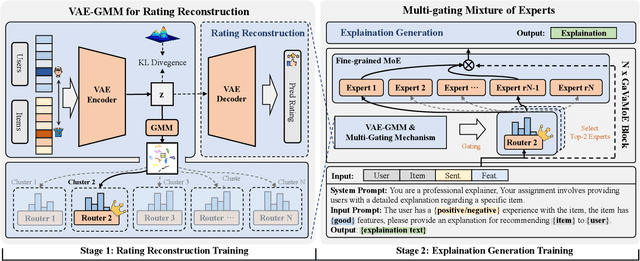
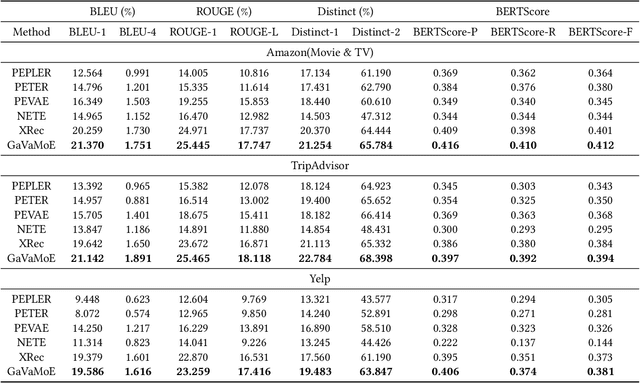
Abstract:Large language model-based explainable recommendation (LLM-based ER) systems show promise in generating human-like explanations for recommendations. However, they face challenges in modeling user-item collaborative preferences, personalizing explanations, and handling sparse user-item interactions. To address these issues, we propose GaVaMoE, a novel Gaussian-Variational Gated Mixture of Experts framework for explainable recommendation. GaVaMoE introduces two key components: (1) a rating reconstruction module that employs Variational Autoencoder (VAE) with a Gaussian Mixture Model (GMM) to capture complex user-item collaborative preferences, serving as a pre-trained multi-gating mechanism; and (2) a set of fine-grained expert models coupled with the multi-gating mechanism for generating highly personalized explanations. The VAE component models latent factors in user-item interactions, while the GMM clusters users with similar behaviors. Each cluster corresponds to a gate in the multi-gating mechanism, routing user-item pairs to appropriate expert models. This architecture enables GaVaMoE to generate tailored explanations for specific user types and preferences, mitigating data sparsity by leveraging user similarities. Extensive experiments on three real-world datasets demonstrate that GaVaMoE significantly outperforms existing methods in explanation quality, personalization, and consistency. Notably, GaVaMoE exhibits robust performance in scenarios with sparse user-item interactions, maintaining high-quality explanations even for users with limited historical data.
Entering Real Social World! Benchmarking the Theory of Mind and Socialization Capabilities of LLMs from a First-person Perspective
Oct 08, 2024Abstract:In the social world, humans possess the capability to infer and reason about others mental states (such as emotions, beliefs, and intentions), known as the Theory of Mind (ToM). Simultaneously, humans own mental states evolve in response to social situations, a capability we refer to as socialization. Together, these capabilities form the foundation of human social interaction. In the era of artificial intelligence (AI), especially with the development of large language models (LLMs), we raise an intriguing question: How do LLMs perform in terms of ToM and socialization capabilities? And more broadly, can these AI models truly enter and navigate the real social world? Existing research evaluating LLMs ToM and socialization capabilities by positioning LLMs as passive observers from a third person perspective, rather than as active participants. However, compared to the third-person perspective, observing and understanding the world from an egocentric first person perspective is a natural approach for both humans and AI agents. The ToM and socialization capabilities of LLMs from a first person perspective, a crucial attribute for advancing embodied AI agents, remain unexplored. To answer the aforementioned questions and bridge the research gap, we introduce EgoSocialArena, a novel framework designed to evaluate and investigate the ToM and socialization capabilities of LLMs from a first person perspective. It encompasses two evaluation environments: static environment and interactive environment, with seven scenarios: Daily Life, Counterfactual, New World, Blackjack, Number Guessing, and Limit Texas Hold em, totaling 2,195 data entries. With EgoSocialArena, we have conducted a comprehensive evaluation of nine advanced LLMs and observed some key insights regarding the future development of LLMs as well as the capabilities levels of the most advanced LLMs currently available.
Multimodal Self-Instruct: Synthetic Abstract Image and Visual Reasoning Instruction Using Language Model
Jul 10, 2024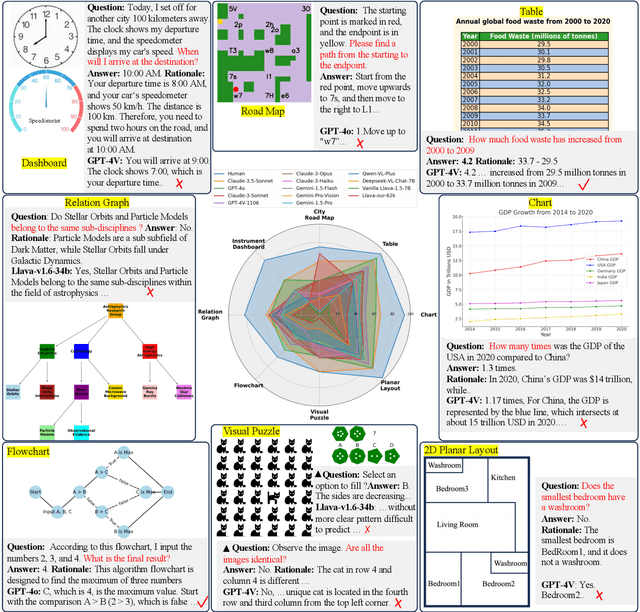
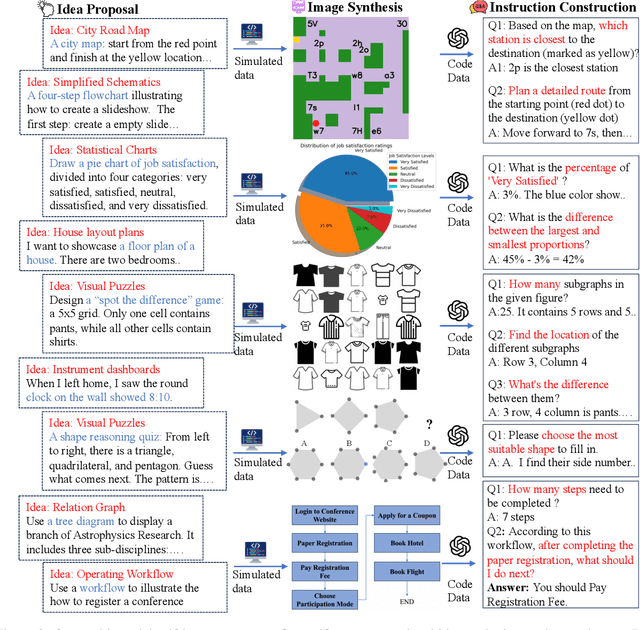
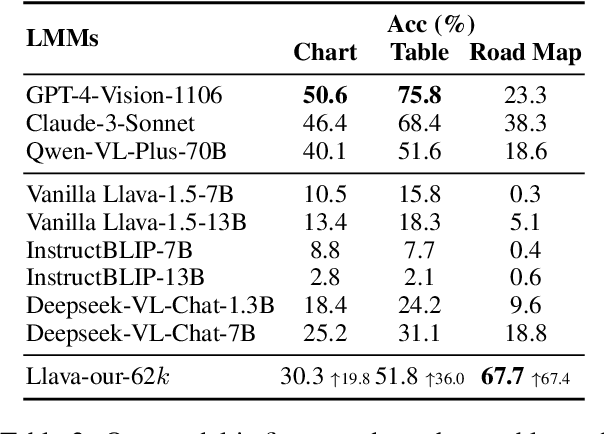
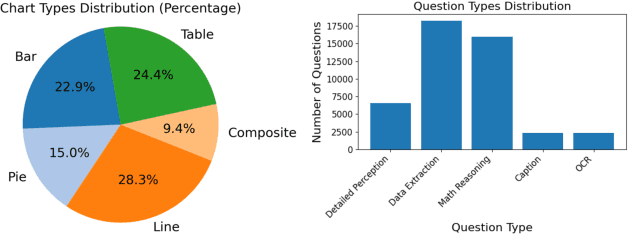
Abstract:Although most current large multimodal models (LMMs) can already understand photos of natural scenes and portraits, their understanding of abstract images, e.g., charts, maps, or layouts, and visual reasoning capabilities remains quite rudimentary. They often struggle with simple daily tasks, such as reading time from a clock, understanding a flowchart, or planning a route using a road map. In light of this, we design a multi-modal self-instruct, utilizing large language models and their code capabilities to synthesize massive abstract images and visual reasoning instructions across daily scenarios. Our strategy effortlessly creates a multimodal benchmark with 11,193 instructions for eight visual scenarios: charts, tables, simulated maps, dashboards, flowcharts, relation graphs, floor plans, and visual puzzles. \textbf{This benchmark, constructed with simple lines and geometric elements, exposes the shortcomings of most advanced LMMs} like Claude-3.5-Sonnet and GPT-4o in abstract image understanding, spatial relations reasoning, and visual element induction. Besides, to verify the quality of our synthetic data, we fine-tune an LMM using 62,476 synthetic chart, table and road map instructions. The results demonstrate improved chart understanding and map navigation performance, and also demonstrate potential benefits for other visual reasoning tasks. Our code is available at: \url{https://github.com/zwq2018/Multi-modal-Self-instruct}.
TimeToM: Temporal Space is the Key to Unlocking the Door of Large Language Models' Theory-of-Mind
Jul 01, 2024Abstract:Theory of Mind (ToM)-the cognitive ability to reason about mental states of ourselves and others, is the foundation of social interaction. Although ToM comes naturally to humans, it poses a significant challenge to even the most advanced Large Language Models (LLMs). Due to the complex logical chains in ToM reasoning, especially in higher-order ToM questions, simply utilizing reasoning methods like Chain of Thought (CoT) will not improve the ToM capabilities of LLMs. We present TimeToM, which constructs a temporal space and uses it as the foundation to improve the ToM capabilities of LLMs in multiple scenarios. Specifically, within the temporal space, we construct Temporal Belief State Chain (TBSC) for each character and inspired by the cognition perspective of the social world model, we divide TBSC into self-world beliefs and social world beliefs, aligning with first-order ToM (first-order beliefs) and higher-order ToM (higher-order beliefs) questions, respectively. Moreover, we design a novel tool-belief solver that, by considering belief communication between characters in temporal space, can transform a character's higher-order beliefs into another character's first-order beliefs under belief communication period. Experimental results indicate that TimeToM can dramatically improve the reasoning performance of LLMs on ToM questions while taking a big step towards coherent and robust ToM reasoning.
Agent-Pro: Learning to Evolve via Policy-Level Reflection and Optimization
Feb 27, 2024



Abstract:Large Language Models exhibit robust problem-solving capabilities for diverse tasks. However, most LLM-based agents are designed as specific task solvers with sophisticated prompt engineering, rather than agents capable of learning and evolving through interactions. These task solvers necessitate manually crafted prompts to inform task rules and regulate LLM behaviors, inherently incapacitating to address complex dynamic scenarios e.g., large interactive games. In light of this, we propose Agent-Pro: an LLM-based Agent with Policy-level Reflection and Optimization that can learn a wealth of expertise from interactive experiences and progressively elevate its behavioral policy. Specifically, it involves a dynamic belief generation and reflection process for policy evolution. Rather than action-level reflection, Agent-Pro iteratively reflects on past trajectories and beliefs, fine-tuning its irrational beliefs for a better policy. Moreover, a depth-first search is employed for policy optimization, ensuring continual enhancement in policy payoffs. Agent-Pro is evaluated across two games: Blackjack and Texas Hold'em, outperforming vanilla LLM and specialized models. Our results show Agent-Pro can learn and evolve in complex and dynamic scenes, which also benefits numerous LLM-based applications.
 Add to Chrome
Add to Chrome Add to Firefox
Add to Firefox Add to Edge
Add to Edge